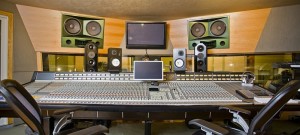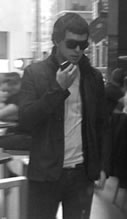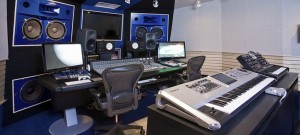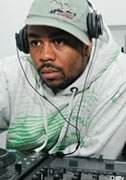Stadiumred Studios Expands: Just Blaze and the Science of NYC Studios
HARLEM, MANHATTAN: As artistic as the purpose of New York City recording studios may be, it’s fair to compare these houses of sound to modern-day warriors. Every one goes into battle with the belief that they’re invincible. Many fall – but some grow stronger.
Uptown, the facility known as Stadium Red Studios became convinced that there was only one sure strategy for thriving in the battle-scarred landscape of NYC: expand, and you’ll be in demand. Marking steady gains since its inception in 2007, when Stadium Red Studios owner Claude Zdanow took over the highly respected but troubled former studio of jazz legend Ornette Coleman at 125th and Park, 2010 sees Stadium Red placing a bold bet that bigger really is better – even when paying NYC prices for your real estate.
The result is a recently completed 2,500 sq. ft. Frank Comentale-designed expansion that sees big names and powerful new capabilities added to the facility. A focused new B-Room is home to hip hop super producer Just Blaze (Jay-Z, Eminem, Saigon, Fabolous, Jamie Foxx, Talib Kweil, Kanye West) and an SSL AWS 900, Augspurger mains, and a digital/analog hybrid production/mix approach. A world-class mastering suite has also been added to house Herb Powers-protégé Ricardo Gutierrez (Justin Timberlake, Usher, John Legend, Jill Scott).
Meanwhile, Stadium Red Studios’ accommodating A-room has gotten its own facelift, swapping in the classic SSL G+ board from Baseline Studios (RIP). Another pair of Augspurger mains with dual 18” subs, a custom Dangerous designed 7.1 surround monitoring system, 24-track tape machine and more are all in there. Mix engineer Tom Lazarus (Ray Charles, Bjork, Yo-Yo Ma, Chicago Symphony), mix engineer Ariel Borujow (T.I., Black Eyed Peas, Puffy, Kanye West), engineer Joseph Pedulla (Thursday, The Mighty Mighty Bosstones, Mos Def, Kid Cudi) and producer Sid “Omen” Brown (Ludacris, Mya, Drake, Fabolus) also maintain their respective residencies throughout the studio. A host of old skool elite amenities – from upgraded lounge to private chef/spa services – are in the mix for good measure.
While the idea of an all-encompassing studio environment of writing/tracking/mixing/mastering is not new, Zdanow believes that it’s the rare human resources he’s gathered – and what they’re on board to do – that will make the Stadium Red Studios expansion stand out. “The idea is that more heads are better than one,” he says. “In studios it can become a stale environment, where the engineer is just a button pusher. What we take pride in is something the artists and labels don’t offer anymore, which is artist development.
“Artists come in here, and when they walk out our brand is attached to them. It’s about letting them know that all these ears are around, whether it’s Yo-Yo Ma, Eminem, or the emerging people we work with. We want to make records here that matter, and the idea is to bring back that creative community — we’re a growing team of NYC engineers and producers that care about NYC and the music scene.”
Zdanow’s energy – driven equally by his spirit of adventure and copious amounts of caffeine – was enough to convince Just Blaze to relocate to Stadium Red Studios after closing his beloved Baseline. “I had known Ariel from before, and he said, ‘You should come look at this space and have a conversation with Claude,’” Blaze relates. “Claude explained his vision, what he wanted to build, and I said, ‘Maybe we can make something work.’ It made sense: The overall vision of the place and the appeal is that it’s a one-stop, end-to-end solution, from recording to mixing to mastering, even doing surround 5.1-7.1.
“So he physically expanded the space, and we combined our resources. It’s a win/win I get a little bit of the stress off my shoulders from running the day-to-day. That allows me to be more creative, but at the same time I have my own space.”
Whether for intensive writing sessions or serious mixing, the new B-room that Just Blaze inhabits was designed to be distinctively accommodating. “It’s gotta be something special — if it’s going to be this meeting of the minds, then it’s got to be something worthwhile,” he emphasizes. “It can’t just be a Pro Tools setup. The way I work, I need all the resources available all the time – I couldn’t go from a G+ to a writing room. And if we’re talking about partnering up and joining our resources to build a business, there’s no point in building something that’s just a production room. That’s something people can put in their houses these days. So you’ve got to take a step further and make it a destination.
“My room is the best of both worlds. If you want to walk in and get down to business in the box, you can do so: We have every plug-in, plus Augspurgers and other monitors. But if you’re a little more old school, you have the SSL and all the gear to go out of the box. Or you can go the third route, in that the AWS can go in and out of the digital world.
“By keeping it smaller we could keep it more affordable. Clients have the SSL, a full suite of plug-ins, Augspurgers – everything that would usually cost you $2500 or more a day, at the fraction of the cost. I think we really hit that sweet spot in terms of sizing. Sometimes you just need a room for production, with a controller or a laptop, but if you’re in this big huge room that’s a waste of money. Or it’s the other way around, and you’re feeling cramped. This place is small enough to feel like a production room, but big enough to feel like a room you can mix comfortably in.”
Arguably, the Stadium Red Studios formula was working already: The studio and its personnel had a part in ten 2010 GRAMMY-nominated projects including Eminem’s Recovery (Album of the Year, Best Rap Album), Drake’s Thank Me Later, (Best Rap Album, Best New Artist), and Steven Mackey’s Dreamhouse (Best Classical Album, Best Orchestral Performance, and Best Engineered Album, Classical).
A good year, all right, but that’s already in the past. Although he’s young – still just in his early 20’s – Zdanow understands that part of moving forward is understanding what didn’t work before, and making adjustments. In that regard, the difficult decision to swap out the A-room’s ICON for the SSL G+ dovetailed with the concept of adding new faces, spaces and capabilities at Stadium Red.
“We’re in an ever-changing industry,” he observes. “When we started out I had a very strong opinion about being versatile and trying to do it all in one room. People appreciated the ICON, but over time we weren’t doing anything as good as we could have been doing it.
“By adding these two rooms, we’ve come to critical mass. People want a lot of options. The ‘A’ room has a big live room where people can track through the console, and mix with tons of outboard gear. Just Blaze’s ‘B’ room is its own environment for production, with the SSL AWS. If you want a powerful controller-based system, you have that in the ‘C4’ room where Ariel Borujow works. So what we realized was that it wasn’t just about one room. There are certain things that need to be in place to do everything — and do it well.”
— David Weiss
Please note: When you buy products through links on this page, we may earn an affiliate commission.










